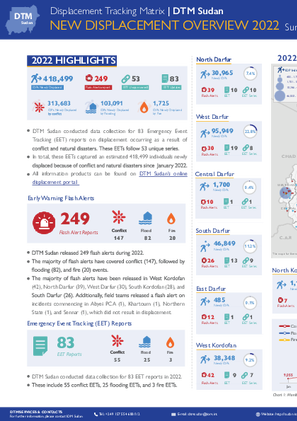-
Countries
-
Data and Analysis
-
Special Focus
-
Crisis Responses
DTM Sudan — New Displacement Overview 2022

Contact
DTM Sudan, DTMSudan@iom.int
Language
English
Location
Sudan
Period Covered
Jan 01 2022
Dec 31 2022
Activity
- Mobility Tracking
- Event Tracking
DTM Sudan deploys its Emergency Event Tracking (EET) methodology to track sudden incidents of displacement, provide more frequent updates on the scale of displacement that occurs between Mobility Tracking rounds, and provide the humanitarian community with a first-of-its-kind evidence base to engage in life-saving and urgent interventions.
As soon as an incident takes place, DTM Sudan’s wide network of over 300 enumerators collect preliminary information on whether displacement has taken place, or potentially could. With this information, DTM Sudan activates Early Warning Flash Alerts within the first 24-48 hours of an incident to notify partners on sudden events here EET activities may subsequently take place. Subsequently, EET can then be activated within 72-96 hours of an incident induced by conflict or natural disaster to assist in rapid response planning.
Just as with Mobility Tracking, the EET methodology utilizes key informant networks to monitor IDPs once displacement has occurred, continuing to track the IDP caseload along several indicators over time. Enumerators collect information on IDP population estimates (households and individuals), place of arrival/departure, locations of origin, reasons for displacement and return, shelter typology, protection vulnerabilities, and priority needs, amongst others. EETs also collect Sex and Age Disaggregated Data (SADD), which provides an insight into the demographic and specific gender nuances present in Sudan and is crucial for designing protection-focused programming and policies which prioritize access to basic services for vulnerable groups, such as women and children.
Through EET, DTM produces an evidence base for strategy and program design and development, humanitarian coordination, and joint funding appeals, as well as informing operational response planning to protect, assist, and advocate on behalf of vulnerable and displaced populations.
